|
|
|
Sort Order |
|
|
|
Items / Page
|
|
|
|
|
|
|
| Srl | Item |
| 1 |
ID:
106265
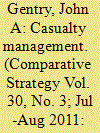

|
|
|
|
|
| Publication |
2011.
|
| Summary/Abstract |
Since World War II, the avoidance, production, and information management of casualties independent of their effects on military forces' combat capabilities have changed political/military operational environments and become major elements of wars' strategies and tactics. Many adversaries of Western states well understand the importance of casualty management. Coherent Western policy and national debates about the strategic consequences of casualties or casualty aversion are lacking, however. This article explores some of the relationships between casualties and military tactics and strategies, domestic and international politics, and operations' outcomes, using the United States as a case study.
|
|
|
|
|
|
|
|
|
|
|
|
|
|
|
|
| 2 |
ID:
106259
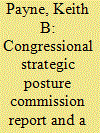

|
|
|
|
|
| Publication |
2011.
|
| Summary/Abstract |
The bipartisan Congressional Strategy Posture Commission offered numerous recommendations to reduce what it labeled "the nuclear danger." The Obama Administration has pursued some of these recommendations via its policy documents, such as the 2010 Nuclear Posture Review, its budgets, and plans. There is reason, however, for several concerns in this regard. These involve the high priority placed on nuclear force reductions at the potential expense of other national goals, including deterrence and assurance; the maintenance of the flexibility and resilience of the U.S. force posture necessary to meet deterrence and assurance requirements now and in the future; continued support for U.S. strategic defensive capabilities given Russian opposition; and apparent interest among some in the Administration to move increasingly toward what has been termed a policy of Minimum Deterrence.
|
|
|
|
|
|
|
|
|
|
|
|
|
|
|
|
| 3 |
ID:
106267
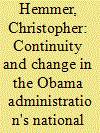

|
|
|
|
|
| Publication |
2011.
|
| Summary/Abstract |
This article examines the Obama Administration's recently released National Security Strategy (May 2010) and compares it with its predecessors. While consistent with its predecessors in its definition of American interests, its stress on U.S. global leadership, and the importance of American values in its foreign policy, it differs from the strategy released by the George W. Bush Administration by offering a more complex view of the international threat environment, favoring multilateralism, stressing America's example over its military might, and in acknowledging the limits of American resources. The fundamental flaw of the current National Security Strategy, a flaw it shares with all its predecessors, is that it ignores concessions, tradeoffs, and hard choices inherent in American foreign policy.
|
|
|
|
|
|
|
|
|
|
|
|
|
|
|
|
| 4 |
ID:
106262


|
|
|
|
|
| Publication |
2011.
|
| Summary/Abstract |
China's traditionally nuclear missile force has added a conventional force component with an inventory of over 1,000 short-range ballistic missiles and an emerging class of theater ballistic and ground-launched cruise missiles. This growing conventional missile force provides Beijing an operational-tactical and strategic capability in theater without the political and practical constraints associated with nuclear-armed missiles. China's emerging inventory of conventional antiship ballistic missiles (ASBMs) affords its military an extra employment option enhancing its layered defense posture against potential offshore threats beyond Taiwan. The military's conventional missiles, operational doctrine, and threat perceptions create conditions for China's escalation to conventional missile attacks against U.S. or allied forces and bases in Asia, including ASBM strikes against U.S. Navy aircraft carriers in any hypothetical China-Taiwan conflict. China's senior leaders would be more likely to authorize such strikes if they endorse the missile force's perceptions of a severe threat to its operations from potential U.S. electronic warfare-based information operations and joint firepower attacks.
|
|
|
|
|
|
|
|
|
|
|
|
|
|
|
|
| 5 |
ID:
106264
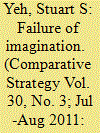

|
|
|
|
|
| Publication |
2011.
|
| Summary/Abstract |
This article analyzes recent advances in unmanned aerial vehicle (UAV) technology and draws three conclusions. First, conventional military forces are highly vulnerable to armed UAVs. A small force of UAVs could decimate entire divisions of soldiers, armor, and artillery, eliminate the ability to resupply and sustain armies in the field, destroy all aircraft in a given theater, and put Nimitz-class carriers out of action. Second, urban population centers are highly vulnerable to UAVs controlled by terrorists. Third, enormous cost savings could be achieved by replacing highly vulnerable and expensive weapon systems with UAVs.
|
|
|
|
|
|
|
|
|
|
|
|
|
|
|
|
| 6 |
ID:
106266
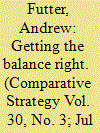

|
|
|
|
|
| Publication |
2011.
|
| Summary/Abstract |
Barack Obama has rightly embraced ballistic missile defense (BMD) as an important component of U.S. national security policy in an era where the requirements of nuclear deterrence are fluid and nuanced. Moreover, the deployment of these defenses may even provide several important benefits to the President's much-publicized nuclear nonproliferation and disarmament agenda. However, if the President's commitment to these goals is to remain credible and viable, then the importance of BMD against rogue states must be balanced with the need to avoid jeopardizing relations with key strategic competitors. As such, the President may have to limit U.S. BMD plans in the near future.
|
|
|
|
|
|
|
|
|
|
|
|
|
|
|
|
|
|
|
|
|